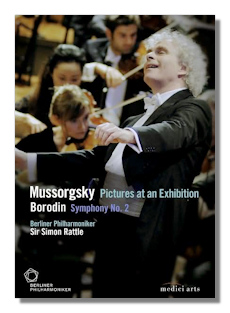
The Internet's Premier Classical Music Source
Related Links
-
Borodin Reviews
Mussorgsky Reviews
Shostakovich Reviews - Latest Reviews
- More Reviews
-
By Composer
-
Collections
DVD & Blu-ray
Books
Concert Reviews
Articles/Interviews
Software
Audio
Search Amazon
Recommended Links
Site News
 DVD Review
DVD Review
New Year's Eve Concert 2007

- Modest Mussorgsky:
- Pictures at an Exhibition
- Khovanshchina: Prelude
- Alexander Borodin:
- Symphony #2 in B minor
- Polovtsian Dances
- Dmitri Shostakovich: Age of Gold, Op. 22: Polka
Berlin Philharmonic Orchestra/Simon Rattle
Recorded Live at the Berlin Philharmonie, December 31, 2007
Medici Arts DVD 2056798 LPCM Stereo Dolby Digital DTS Anamorphic Widescreen
Also available, minus Shostakovich, on EMI CD 517582-2:
Amazon
- UK
- Germany
- Canada
- France
- Japan
- ArkivMusic
- CD Universe
It's the Borodin Second Symphony that comes across best here. While this work hasn't exactly been neglected over the years, it still doesn't appear on concert programs with great frequency. What probably has hampered its greater popularity is its lack of bigness: none of the four movements run longer than nine minutes, and the whole generally clocks in at under a half-hour. The first movement features a truly dark Russian-flavored main theme that, in the wrong hands, can sound somewhat corny or shallow. It sounds almost like a distant cousin of the famous opening theme of the Liszt First Piano Concerto, only it is not thumbing its nose at anyone as the Liszt is reputed to be. Rattle invests Borodin's theme with a sense of angst, even menace. In the development section, a sped-up version of it sprinkles the intensifying music with energetic drive. At the climax of this section, the theme returns to its original guise, only now it is majestic but somewhat ominous as well.
The first movement is really a sort of study in contrasts, with the main theme standing opposite to the generally bright and colorful character of the other material, especially the lovely alternate theme. Rattle handles the contrasts well, never shortchanging the darker elements and not viewing the other music as just folk-tinged light fare.
The Scherzo, the shortest of the four movements, features what is probably this work's most memorable melody, the dreamy, somewhat exotic Allegretto theme that makes up the middle section. It certainly points up the connection between this work and the Polovtsian Dances. The third movement, with its long-breathed, wistful main theme first heard on the horn, turns tense in the middle section, but eventually ends peacefully.
The finale is lively and joyous, with a very active tambourine. Again, the alternate theme seems a close relative of the Polovtsian Dances. Here, and throughout the Berlin Philharmonic catch all the Russian colors, as well as Borodin's many contrasts, with spirit and precision. Rattle and the Berliners turn in a performance to rival the best by any of the Russian orchestras.
The Polovtsian Dances are also well played here, as is the Mussorgsky Khovanshchina Prelude. The other major work on the disc, Pictures at an Exhibition, is precisely, imaginatively and colorfully rendered. Rattle and the Berliners can be proud of this richly atmospheric and powerful performance. But more and more, I come to regard this orchestration by Ravel as a misstep. Oh, it's brilliantly conceived and shows Ravel's mastery of orchestral color and nuance, but at times it seems to go over the top with bell and percussion effects and with its apparent intention to expand upon Mussorgsky's comparatively modest piano score. It also sands some of the rougher Russian edges and replaces them with a Gallic charm. My view may be a minority one, I realize, since this is an immensely popular orchestral work. There are tons of other orchestral versions of the work by the likes of Leopold Stokowski, Sergei Gorchakov, Lucien Caillet, Walter Goehr and Vladimir Ashkenazy, to name a few. Still, even though Mussorgsky's original piano score seems to cry out for a larger incarnation, I'm not sure it is better served by Ravel or any of the others.
None of this is Rattle's fault, of course. So, if you like this Ravel scoring, this performance is certainly worth obtaining, especially because of its disc mate, the Borodin Second. The Shostakovich polka is a nice closing filler to this splendid New Year's Eve concert from 2007. The sound is vivid and powerful and the camera work intelligently handled in all works. Strongly recommended.
Copyright © 2009, Robert Cummings




















